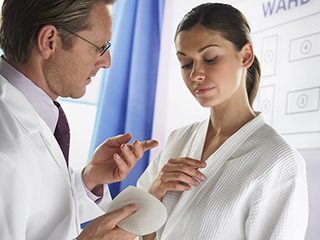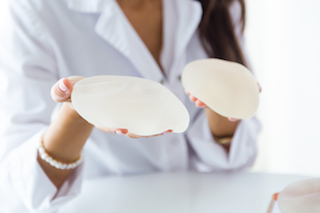Free-flap breast reconstruction: A natural alternative to implants after cancer
May 2, 2019

After breast cancer, many women can choose to have reconstructive surgery in order to look and feel like themselves again. While breast implants are a safe and popular choice, free-flap reconstruction has emerged at advanced breast centers like UT Southwestern as a more natural, longer-lasting option.
Free-flap reconstruction involves the transfer of tissues and blood vessels from a patient’s lower abdomen, lower back, or thighs to sculpt a new breast. This intricate procedure requires microsurgical reconstructive and plastic surgery skills, blood vessel surgery expertise, and a specialized care team to support streamlined recovery.
“In North Texas, we are among a handful of medical centers that offer free-flap breast reconstruction. We operate as a two-physician surgical team, so we are able to provide more women with reconstructions and ensure optimal results. Our flap success rate is around 99 percent, based on having performed approximately 1,500 flap reconstructions since 2012.”
In North Texas, we are among a handful of medical centers that offer free-flap breast reconstruction. We operate as a two-physician surgical team, so we are able to provide more women with reconstructions and ensure optimal results. Our flap success rate is around 99 percent, based on having performed approximately 1,500 flap reconstructions since 2012.
Admittedly, it sounds a bit visually dramatic to move a patient’s own tissues from one part of the body to another. However, many women prefer the option to use their own natural tissue instead of having a prosthetic implant placed in their breast. Our patients can choose from five types or categories of free-flap procedures; every woman’s anatomy is unique, and every breast reconstruction procedure is personalized to her needs and goals.
5 types of free-flap surgery
The procedures we offer are classified by the donor tissue site, or the area of the body from which we remove healthy tissue and blood vessels to craft the new breast:
- DIEP/SIEA (deep inferior epigastric perforator/superficial inferior epigastric artery) flap: Tissue is moved from the lower abdominal midsection to the breast. In a subcategory at UT Southwestern, we have performed the largest series of single-breast double stacked-DIEP flap procedures to date (more than 200 flaps).
- LAP (lumbar artery perforator) flap: We transfer tissue from the lower back and/or upper buttock. Our team performed the first LAP flap in North Texas in December 2018 and followed that with another successful procedure the same month.
- PAP (profunda artery perforator) flap: Donor tissue comes from the back of the inner thigh, below the buttock. We performed the first PAP flap in North Texas several years ago, and we have performed the largest series of this procedure in the world to date (more than 250 flaps).
- Quadruple 4-flap: This variation is a rare combination of multiple free flaps; it is most commonly done for women who have both breasts reconstructed. Donor tissue is usually taken from the lower abdomen and the thigh, or sometimes the lower back. We did the first quadruple flap procedure in North Texas and have performed the largest series of this procedure in the world to date (200 flaps in 50 patients).
- Stacked flaps: Generally, tissues are moved from more than one place (similar to 4-flap surgery). We have performed one of the largest series at a single institution in the world.
High-volume, streamlined centers benefit patients
UT Southwestern is among the highest-volume centers in the U.S. for free-flap breast reconstruction. Success requires experience and continual refinement of processes and techniques.
As such, we are fortunate to have helped build an efficient, one-of-a-kind team and stringent processes to ensure optimal patient outcomes. Our core team includes anesthesiologists, pain control experts, breast cancer nurses, and core surgical team members who understand the intricacies of microsurgery and plastic surgery. All patients recover in the intensive care unit, where specialized nurses monitor their progress.
Additionally, our co-surgery model of two faculty board-certified microsurgeons is patient-centric and highly efficient in an academic setting. We consult with patients together and perform every free-flap procedure in tandem. This process allows us to provide innovative solutions for every patient’s unique anatomy and needs.
Under this model, we perform approximately 250 to 300 free-flap reconstructions each year between two surgeons.
Should a woman choose implants or flap reconstruction?
As with any surgery, both options have benefits and risks to consider. In either case, family and social support is key to successful recovery. Breast cancer and reconstructive surgeries can be emotionally and physically taxing – it is essential for patients to understand what to expect during recovery and to prepare for potential challenges.
Implants

Breast implants are a safe and popular choice for breast reconstruction. The main disadvantage of implants compared to free-flap surgery is that implants must be replaced at certain points in life due to age-related body changes, failure of the implant, or age of the implant. If a woman has reconstructive surgery in her 20s or 30s, she might require more than one replacement procedure in her lifetime.
Women who choose implants typically can go home the day of surgery. The majority of patients tolerate the surgery well and recover without complications. Risks can include infection at the surgical site and loss of the implant, the latter of which requires additional surgery.
One note of caution: Women who have radiation therapy as part of their cancer treatment tend to have an increased lifetime risk of complications with implants. We counsel these patients to consider free-flap reconstruction, though it is ultimately the patient’s choice and implants can still be accommodated.
Free-flap reconstruction
Free-flap reconstruction is considered more soft-tissue restorative than implants – the breast lasts forever without the worry of a foreign body, such as an implant. Straightforward procedures typically take four to six hours; more complex reconstructions take more time. Most women stay in the hospital for two days under the care of specialized nurses. Because of this refined and repetitive process, our patients have better outcomes and experience less pain than could be expected in a typical hospital setting.
Recovery is based more on the healing of the donor site than the breast itself. After surgery, we recommend that our patients restrict significant movement for 4 to 6 weeks to allow the donor site to fully heal. Some women experience scabbing, minor delayed healing, or infection at the donor site.
Our free-flap procedures are successful 99 percent of the time; however, there is about 1 percent risk of flap failure. If a blood vessel in the new breast tissue becomes blocked, the flap tissue can die, requiring emergency surgery.
Women with significant medical problems who are unhealthy might not be able to safely undergo free-flap reconstruction. Additionally, women who have clotting issues, diabetes, or morbid obesity, as well as women who smoke, are at greater risk for complications. These women might be able to have the procedure under unique situations.
A few closing thoughts
Breast reconstruction is a personal choice – it is not required for women who have breast cancer surgery. And it’s important to note that women don’t have to decide right away whether to have reconstruction. Some women choose to wait several years to have it done; others choose to never pursue it. Whatever a patient decides, we will support her decision and educate her about safe choices.
While free-flap reconstruction might sound invasive, we always strive to manage and help conceal surgical scars for a more natural appearance. No two women are built the same, so every procedure is personalized. Together, we offer patients more creative leeway to achieve the breast look and feel they desire with one of the most experienced breast care teams in North Texas.
To find out whether you or a loved one might benefit from a consultation about free-flap breast reconstruction, call 214-645-8300 or request an appointment online.












